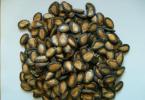Today we are going to deviate a little from the usual structure of such ratings - “best mineral / semi-synthetic / synthetic oil”. The reason is simple: a particular engine first of all needs the oil viscosity specified by the manufacturer, and modern engines use low-viscosity lubricants (this is usually a high-temperature viscosity of 30, on many engines it is 20). Discussing anything other than synthetics in this context is silly. No less strange is the division into categories "gasoline / diesel engine oil", given that 90% modern oils are approved for use in both types of engines, it makes sense to discuss purely “diesel” oil in relation to passenger cars only in the segment of oils intended for engines with particulate filters.
Therefore, today we will divide motor oils into categories of their specific application, and not by virtual and not having practical sense parameters:
- Oils with high temperature viscosity 40(5W40 in our ranking) - the best option for engines produced in the 90s - early 2000s. For regions of the Far North, it makes sense to consider 0W40 oils, this can significantly facilitate starting the engine in winter.
- 5 W30 today can be considered universal: this viscosity is also used in budget foreign cars, and in premium car engines.
- 0 W20- low-viscosity motor oils used in large quantities modern engines. Moreover, pouring more viscous oils into them is categorically not recommended: piston rings, which have specially reduced elasticity to reduce mechanical losses, cannot cope with a stronger oil film, oil waste begins to grow.
- High temperature viscosity 50 relevant for owners who operate their cars harshly - it is not without reason that 5W50, 10W60 oils are commonly called "sports".
- 10W40- the standard choice of owners of old cars, as a rule, is budget semi-synthetics of outdated quality classes - SH, SJ.
- Diesel engines with particulate filters should have a minimum oil loss, which should not give a noticeable solid residue (low ash content). This parameter is critical, therefore, in motors similar cars it is allowed to fill in only oils that have the appropriate certification. Overwhelming majority passenger diesel engines of this type, oils with a viscosity of 5W30 are used, and we will consider them.
The choice of oil for modern driver— it’s not an easy task: you want to save the budget and buy a high-quality product. Today, experts give very specific recommendations on the choice of oil, and experienced motorists, of course, listen to them. It remains, in fact, to choose only the manufacturer, but this is not as easy as it seems at first glance. One who respects and appreciates his iron horse seeks to acquire "food" for him elite class- synthetic oil. But often inside a bright canister with the signature FULL SYNTHETIC is not at all the liquid that a caring car enthusiast expected to see. The problem is that Russian legislation does not yet provide for the gradation of oils, but modern market There are 4 varieties of this type of product. How to understand this issue and not be disappointed in your purchase?
What is real synthetic oil?
Synthetic oil in its original meaning is a product synthesized from light molecules of PAO hydrocarbons, which has a homogeneous molecular composition without impurities of complex hydrocarbons and paraffins, as well as a number of unique physical and chemical properties. The technology for the production of such motor oil is quite complex and expensive, so for a long time this product was available only in the professional racing segment. Later, synthetic oil also got on Russian market, however, the "namesake" was already waiting for him on the shelves - a synthetic oil made according to the principle of HC hydrocracking.
What is the peculiarity of synthetics obtained by hydrocracking?
HC synthetics are more affordable than PAO synthetics, but they require more frequent replacement: in urban conditions, this is every 10 thousand kilometers. Hydrocracking technology involves the purification of the base mineral oil from harmful impurities and the destruction of long molecular chains of the product base. That is, oil is synthesized not from lighter hydrocarbons, but from heavier ones. Its properties, of course, are incomparably better than those of ordinary mineral, but it is still far from synthetic hydrocarbon PAO.
Experienced drivers have already noticed a number of problems that they face when dealing with such a "budget" oil. Disappointing statistics recent years recorded the failure of a huge number of cars in winter time years due to gelation (gelation) of engine oil made using hydrocracking technology. Laboratory studies by a number of independent companies have shown that after a run of 3-5 thousand kilometers, the engine oil changes chemical composition and freezes at -5C. Manufacturers blame the use low-quality fuel, journalists, on the contrary, are butter. However, experimentally, one of the oil companies found that the artificial introduction of paraffins unusual for oil in a volume of 6% leads to thickening of 5w40 (oil based on HC hydrocracking), but does not affect 0w40 and 0w30 (synthesized from PHA).
How to find high-quality synthetics?
The first thing you should pay attention to is the location of the oil producer. To date, Germany is the only country where the type of synthetic oil is fixed by law. So, choosing a German canister with the inscription vollsynthetisches, you can be sure that you are purchasing a quality product. Other producing countries are more loyal to the labeling of oils: if European countries At least they put the label HC-synthetic on the product, then Japan, Korea and the USA, under the guise of synthetics, will gladly sell you hydrocracking, semi-synthetic (with a minimum proportion of synthetics of 10%), or even mineral oils. It remains only to rely on yourself and carefully study everything that is written in the smallest print on the packaging.
Another way out is to use proven products. So, German company Liqui Moly with half a century of history and unshakable reputation, known to motorists in more than 110 countries, offers wide choose synthetic motor oils.

The Synthoil series is:
- 100% synthetic base from PAO hydrocarbons;
- highest resistance to oxidation;
- stability at low temperatures launch;
- resistance to temperature extremes and overloads;
- caring for the cleanliness and protection of the engine;
- high level of antifriction properties;
- fuel economy due to reduced friction;
- low oil consumption for waste;
- stable chemical composition;
- long service interval.

When choosing oil for your vehicle, the driver must first decide what he wants: to save cash or get a quality product that will last a long time. It must be remembered that from HC-synthetics the same operational properties, as from PAO-synthetics, should not be expected. Monitoring of modern autochemistry has shown that real synthetic oils cannot cost less than 500 rubles per liter.





If the title put you in a stupor - great. This is what we were striving for. Let's try and write it differently: "Choose engine oil: HC-synthetic or PAO-synthetic? So it became clearer? No! Well, then you are welcome to clarify.
Dear our motorists. Oil company marketing departments have been telling you for years that synthetic oil is good for the engine. And now you all know it very well. But the fact that there are two types of synthetic oil is known to a few. And it would be worth looking into this issue. Indeed, its consumer properties and cost depend on what type the synthetic oil base belongs to - HC-synthetics or PAO-synthetics. What is hidden behind these abbreviations?
What is HC Synthetics?
If HC-synthetics is written on the engine oil can, this means that base oil, from which it is made, is produced using hydrocracking technology from heavy petroleum products. Those who are interested in the details of the technology can “google” on their own. We will restrict ourselves to a simplified description so that the reader can simply compose general idea about her. So, during hydrocracking, harmful impurities are removed from the base mineral oil and long molecular chains are destroyed. That is, oil is synthesized from heavy hydrocarbons.
What is PAO Synthetics?
Base oils related to PAO-synthetics are produced from gas. This is due to the synthesis of polyalphaolefins (PAO) from light hydrocarbons, which are the basis of this type oils. This technology produces a substance with a homogeneous molecular composition, devoid of impurities of sulfur and metals.
Light or heavy
At first glance, there is no difference in how this or that oil base of the same commercial viscosity, for example, 5W30, is obtained. But the practice of operating motor oils suggests otherwise. The most important difference lies in the thermal-oxidative stability of the oil, or, more simply, in the duration of the oil service interval before it thickens. This is most clearly illustrated in the diagram below.

Why is thermal and oxidative stability important?
An inexperienced reader may ask: “Why should I care about the thermal-oxidative stability of engine oil if I strictly follow the recommendations of the automaker on the timing of its replacement?” This question needs to be examined in more detail: is it so? Can an average car enthusiast living in a metropolis clearly fulfill the requirements of automakers regarding the timing of engine oil change?
Let's guess. Let the engine oil change period be every 15 thousand km. And our conditional driver will drive 50 km to work every day. At the same time, he will spend an average of 1 hour in the morning and 1 hour in the evening on the road. With this mode of operation, the need to change the oil, judging by the odometer, will come in 300 days or, roughly speaking, in a year. During this time, the engine will run 600 hours. And how much can you drive in 600 hours if you do not stand in traffic jams and if the engine is running at 2500 rpm (in direct gear this corresponds to a speed of 90-100 km / h)? Multiplied? It turns out 60,000 km. Those. it turns out that for our conditional resident of the metropolis, the engine gets a four-fold (!!!) overrun of oil during the service interval. Can you imagine what will accumulate in the engine during this time? That is why the thermal-oxidative stability of engine oil is so important for urban car operation.
Automakers are fully faced with that problem. Ten years ago, there was a marketing competition between them in who would claim a longer service interval. But now all official service points reduce the actual oil change interval. This is done quietly, without loud advertising. This happens on the basis that in each service book there was a special footnote. She says that a shorter engine oil change interval is recommended when " difficult conditions exploitation". Such conditions include traffic in traffic jams in our big cities!
How to replace synthetics?
Let's return to the beginning of our story - to engine oil. Today, the main type of oil used in modern cars- Is it pure synthetic. And by virtue of economic reasons, this is HC-synthetics, i.e. product manufactured using hydrocracking technology. On the Internet, you can find a lot of discussion about the stability and quality of motor oils from different manufacturers. But if you look at the results of laboratory tests, it turns out that the difference in "quality" between products different brands, in units of interservice run, does not exceed 25-30%. This is also a lot, but it certainly will not block even a two-fold overrun of engine oil.
In this case, the solution lies, as always, on the surface. This is a transition to a different type of base for PAO-synthetics. And what I like most about this decision is that it is made by the car owner himself and does not depend on car manufacturers.

Benefits of POA Synthetics
The first to fully appreciate the performance of motor oils based on PHA synthetics were race car drivers. During the competition, the engine can work out its resource in one race: the pilot does not spare him in any way, trying to squeeze out everything that he is capable of from the forced engine. And here the special properties of oils of this type, which we have not yet touched upon in our story, came in handy. Let's list them.
- High antifriction properties;
- Fuel economy due to reduced friction;
- Resistance of engine parts to thermal overloads;
- Low oil consumption for waste;
- High resistance to oxidation during operation.
All this made it possible to squeeze the maximum out of the engine and at the same time reach the finish line.
From the sports "stables" POA-synthetics began to migrate to civilian cars, until it was quietly replaced by HC-synthetics.
The reverse transition from HC-synthetics to PHA-synthetics is already possible from a new level of understanding of what the user gains from this transition. After all, in addition to the above qualities that are relevant for motorsport, a simple user receives several more advantages in the daily operation of the machine. Here they are:
- Stability of chemical properties during the entire period of use;
- Engine cleanliness due to high detergent properties;
- Confident engine start at low temperatures;
- Extended service interval.
Clearly there is something to fight for.
Oil for perfectionists?
When you talk to the oil industry about fully synthetic motor oils (that's another common name for PHA synthetics), everyone talks about positioning this product as a perfectionist and racing oil. Accepting their opinion, I felt some kind of dissonance in the depths of my soul, and during the preparation of the article, I was finally able to reflect it. I realized that I did not agree with them. I do not agree, first of all, with such a narrowing target audience. Of course, if you like to race, you can't do without POA synthetics. But this is not only oil for those who like to buy the most expensive.
POA synthetics - a product for the thrifty!
Let me explain my position. PHA-synthetics are more expensive than HC-synthetics, but not by much - by about 30%. At the same time, it almost doubles it in terms of thermal stability, without taking into account additional positive properties. This allows you to protect the engine and avoid it increased wear, increase the interservice mileage and, ultimately, get best condition engine during operation. This results in savings on both possible maintenance and fuel. Moreover, the use of PAO-synthetics is especially important for modern heat-loaded engines, which also have structurally narrowed oil channels. After all, the channel was clogged, and the engine was “covered”. When using a fully synthetic oil, such a development of events is excluded.
How to buy POA synthetics?
A question that seems banal in the era of victorious capitalism, but relevant when making a purchase. How can a simple consumer find exactly fully synthetic oil, and not oil made using hydrocracking technology, in the “collapses” of stores?
Unfortunately, we can state that this is not an easy task. Russian consumer legislation does not distinguish between these two types of synthetics, unlike, for example, German. The websites of oil manufacturers on their pages talk about everything, except what kind of base oil is used. Information about the base of the oil has to be sought in the same way as information about the composition of food additives in products - that is, read the text written in small print on the label.
Here are a few simple recommendations on how to independently deal with the inscriptions on the oil canister. So, European manufacturers oils, as a rule, make a reference in the specification to the oil that it is made using HC technology (hydrocracking) or they write that the oil is "HC-synthetic". At the same time, both Japanese, Korean and American manufacturers oils boldly call their, in fact, mineral or hydrocracking oils 100% or FULL SYNTHETIC. It is possible to really figure out what kind of oil is in the canister only in a complex laboratory way. But there are a few little things that you can pay attention to when choosing an oil:
- If the oils are produced in Germany, then the inscription "vollsynthetisches" is usually sufficient, since Germany is the only country where the concept of synthetic oil is legally defined.
- If the label says "HC-synthetic" or "HC", these are hydrocracked oils and are not PAO synthetics.
- If the oils go in the 0W- gradation, then their base is in most cases synthetic.
- Real synthetic oils cannot cost less than 450 rubles per liter.
- Oils 5W-, 10W-, 15W-, 20W are mostly "semi-synthetic" or "hydrocracking".
Somewhat apart in this secret list is LIQUI MOLY, which, in order to avoid mixing, presents separate lines of motor oils with bases from HC-synthetics and PAO synthetics. So, HC synthetics are represented by the LIQUI MOLY Top Tec oil line, and PAO synthetics are LIQUI MOLY Synthoil. There are a number of companies that separately distinguish hydrocracking synthetics and PAO synthetics. It is on their products that we recommend focusing.

Brief answers to questions
For those interested in the topic
Question: There is a perception that synthetic oils are more fluid, which can cause leakage through oil seals and motor seals. Is it true?
Answer: No, synthetic oils by themselves cannot cause a leak on a serviceable engine with unworn seals and oil seals! Leaks are usually caused by age and use. mineral oils, from which the seals simply harden (tan) and lose their working elasticity.
Question from the older generation: Will the use of synthetic-based engine oil adversely affect the warranty vehicle?
Answer: Of course not. Almost all the giants of the global automotive industry already fill in synthetic motor oils at the factory and recommend them for further use, including at the end of the warranty period!
IMPORTANT: in order not to lose the warranty on the car, use the oil recommended by the manufacturer of the car viscosity, in accordance with the season and region of operation. It is also important not to exceed the oil change intervals set by the vehicle manufacturer..
Question: Is a new engine running in mineral oil required? And only then it is necessary to switch to synthetics?
Answer: No, this is a long-standing misconception. The running-in of a new engine and subsequent operation can and should be carried out on synthetic motor oils. The best confirmation of this is above: that synthetics are poured into new engines already on the assembly line of the car manufacturer!
Question: Is it true that the scope of synthetic motor oils mainly extends to ultra-modern high-tech cars or when operating a car in extreme weather (temperature) conditions, as well as in the "taxi" mode, etc.?
Answer: No, again an erroneous opinion. Synthetic engine oils (taking into account viscosity and SAE / API class) can be used on absolutely any type of car, in any region of operation and in any load class. How more difficult conditions operation of the car, the more obvious the advantages of synthetic-based oils over standard mineral "colleagues" become. The highest degree of engine protection at low temperatures the best way affects the resource, while at the same time greatly facilitating the launch.
Question: Does the consumption (waste) increase when using synthetic-based oils compared to mineral ones?
Answer: Wrong again: on the contrary, synthetics, in a serviceable (non-worn) engine, require less attention to level control than mineral oils. Waste is the fate of the decomposition of basic mineral bases, synthetic ones are more stable in all respects.
Question: Comparing the cost of mineral oils with synthetic ones, one gets the impression that the use of the latter is inappropriate, as they are less economical.
Answer: Naturally, synthetic oils are more expensive, but at the same time they are more economical than mineral water - fast start in cold weather, early recovery, improved lubrication at high temperatures and overloads - fuel economy, more long life oil - less often replacement, saving on "topping up" (it is simply not required). We add to this the increased resource of the unit itself and draw an unambiguous conclusion in favor of synthetic motor oils.
Question: How do synthetics deal with varnish deposits and sludge?
Answer: Let's repeat: the problems described in the question are the prerogative of mineral oils, while synthetic oils are many times higher than mineral oils in all "disciplines".
Question: Is it necessary to flush the engine before using synthetic oils?
Answer: See the answer to the first question :)
Question: Should synthetic oils be used in high mileage car engines?
Answer: It makes no difference at what mileage you decide to replace mineral oil with synthetic oil, a new car or a battered one. From the moment you switch to synthetic motor oil, you can be sure that the engine is fully protected, and some ICE performance will be noticeably improved. Thanks to detergent additives (contained in synthetics), on a used car, you can put your engine in order by washing off high and low temperature deposits. Returning to the topic of flushing - unlike "five-minute" and even full-volume flushes of the engine lubrication system, Mobil synthetic motor oils wash off deposits gently (smoothly), and you do not risk clogging the oil channels with large pieces of sludge.
Question: Synthetic engine oil quickly turned black, does this mean that it needs to be changed urgently?
Answer: No, a quick change in the color of fresh synthetic oil indicates that detergent additives work by washing off old deposits on engine parts. This is especially true for diesel engines. If you have been using exclusively synthetic oils since purchase, black on oil dipstick level control you will never see! The only exception, again, are diesel engines- unfortunately, the amount of soot in the domestic diesel fuel, as well as sulfur compounds, exceeds all permissible standards.
|
|



